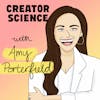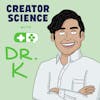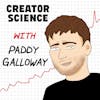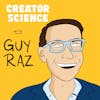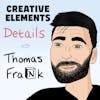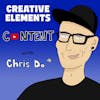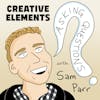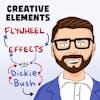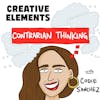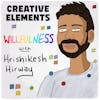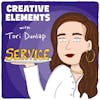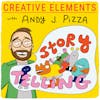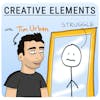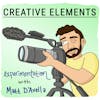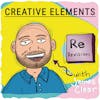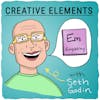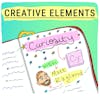
#36: Matt Ragland – Becoming a full time YouTube creator after 10 years of side hustling
Play EpisodeMatt Ragland is an independent creator. His YouTube channel showcases videos on the Bullet Journal process, productivity, and time management.
Matt Ragland is an independent creator. His YouTube channel showcases videos on the Bullet Journal process, productivity, and time management.
Previous to going full time as a creator in 2020, Matt worked in customer success as employee #5 at ConvertKit and later as a Director of Customer Success at Podia.
In this episode we talk about Matt’s journey starting with blogging in 2010, his time at ConvertKit and Podia, how to construct multiple products at different price points, breaking through on YouTube, and how his curiosity has helped him find a path to going all in as a full-time creator.
Transcript and show notes can be found here
***
LISTENER SUPPORT
Join our community on Facebook
Support this show through Buy Me A Coffee.
***
SPONSORS
Try Podia and save 15% for life as a Creative Elements listener
Start your free trial of SavvyCal and get your first month free using promo code ELEMENTS
***
ABOUT JAY CLOUSE
Subscribe to my weekly newsletter
Enroll in my course on podcasting, Podcast Like The Pros
***
PODGLOMERATE NETWORK
This show is a part of the Podglomerate network, a company that produces, distributes, and monetizes podcasts. We encourage you to visit the website and sign up for our newsletter for more information about our shows, launches, and events. For more information on how The Podglomerate treats data, please see our Privacy Policy.
Since you're listening to Creative Elements, we'd like to suggest you also try other Podglomerate shows surrounding entrepreneurship, business, and careers like Rocketship.fm and Freelance to Founder.
Learn more about your ad choices. Visit megaphone.fm/adchoices
Matt Ragland 0:00
So I published it, I think on like December 23 2017. And within three days, it was over 1000 views. And within a week, I had gone from, like 650 subscribers to over 1000 subscribers.
Jay Clouse 0:17
Welcome to Creative Elements, a show where we talk to your favorite creators and learn what it takes to make a living from your art and creativity. I'm your host, Jay Clouse. Let's start the show.
Jay Clouse
Hello, another week, another new episode of Creative Elements. Thanks so much for tuning in. I hope you're doing well wherever you are, whatever you're up to while you're here listening with me. You know, those people in your life that are basically just internet friends, people you feel like you're really no like a real friend, but you've never actually met. Today's interview is with one of my internet friends Matt Ragland. Matt is someone I've been connected with on Twitter for several years. He lives in Nashville, Tennessee, I live in Columbus, Ohio, so we're not that far away. And we have so many mutual friends that we felt like we are friends to, despite having never actually met. So this conversation is literally our first ever face to face real time conversation, which feels crazy because it was so easy to talk with Matt, as soon as I got on the line, it just felt like we'd known each other for a very long time. And there's a very good reason to be talking with Matt today. Just about a month ago, on October 26 2020, Matt announced that he was going to be leaving his full time job. His tweet reads quote, big news. This is my last week at Podia. I'm going to be a full time creator. This journey started in 2010. When I set up my first blog, I start a podcast in 2013. And 2017, I started my YouTube channel. Now it's 2020. And I'm doing the damn thing. Wow. And quote. Now let me say right off the bat, Matt has had an awesome startup career. He joined ConvertKit in 2015, and then moved on to podia in 2018. These are literally two of my favorite companies and two of my most useful pieces of software in my own business. Seriously, I would be remiss if I didn't say that ConvertKit is an unbelievable email marketing tool. And Podia is my favorite platform. For course creation. podia has been a longtime sponsor of this show. In creative elements, listeners save 15% by visiting JayClouse.com/podia. I'm also a ConvertKit affiliate. So if you're ready to level up your email marketing visit JayClouse.com/ConvertKit to learn more. Okay, back to Matt, back to the reason that we're here, Matt's YouTube channel has taken off over the last few years where he makes videos about the bullet journal process, productivity and time management.
Matt Ragland 2:43
Hi, everyone. My name is Matt and welcome to another Bullet Journal Productivity video. In this episode, I'm really excited to share with you a simple three step habit loop that you can use to build good habits.
Jay Clouse 3:00
I love Matt's story. Because as he very succinctly shared in his announcement tweet he's been creating for 10 years. Since you're listening to this show, chances are you've thought about going full time as a creator yourself. But you may not have been working at it for 10 years, like Matt has. And at the same time, Matt has had the opportunity to work at two really great companies in the creator space. So not only is going full time as a creator scary, but it means giving up a startup career that he worked really hard for. Last month, he made a really great video to illustrate this tension called I quit my job for YouTube, where he has a conversation with himself through two characters, Startup Matt and Creator Matt.
Matt Ragland 3:45
Startup Matt? Yeah, that's me the one and only. What are you doing here? Is it true? That you, me, us director at a successful startup now? Oh, yeah, you mean Podia those does a great job. I really love being there. Nice. Yes. We did it five years so much hard work at wait, was a good job. Enjoyed being there? Past tense. Yeah, I work for myself. Now. I'm really excited. There's just it's only been a couple of weeks. But I have so many ideas and. What did you get fired? Because there was that time that we almost got fired? Did you actually get fired this time? No, I, I quit. I quit on my own terms. Okay, we're gonna, we're gonna have to backtrack. I'm gonna have to backtrack. You know how hard we worked for this. This was the big goal. This is what we I this is what I worked for. And you're just gonna throw it all away. You were a director at a successful startup. And now what? I know. And the people were awesome. They were very kind and supportive. And we did a ton of great work together. You know how much money you were making, right? Yeah. more money than I've ever made in my life. Oh my gosh. Okay, more than we made in three years combined, not too long ago.
Jay Clouse 5:25
I love this video, and a link to the full version is in the show notes. Matt story is super relatable, and also super aspirational. So in this episode, we talk about creator man's journey starting with blogging in 2010. Startup Matt's time at ConvertKit and podia. How to construct multiple products at different price points, breaking through on YouTube, and how his curiosity has helped him find a path to going all in as a full time creator. I'll be sharing some immense videos this week in our Creative Elements, listeners group on Facebook. So join us there if you haven't already. The link to that is also in the show notes. And I'd love to hear your thoughts on this episode. As you listen, you can find me on Twitter or Instagram @JayClouse, let me know that you're listening. But now, let's hear from Matt.
Matt Ragland 6:12
10 years ago, really does feel a lifetime ago and a 10 years is a pretty good amount of time. But to do things on the internet, it feels even longer. And that amount of time. 2010 just trying to write a couple of times a month. You know, while I was working at a summer camp in North Carolina camp Brockman for boys was the job that I had at that time. And I just started and starting to write starting to share. I was reading a lot of books on writing and storytelling. And I had been going through like Joseph Campbell's Man of a 1000 faces in the power of myth and Jeff Goins, and Michael Hyatt and just a lot of people that I was reading about in terms of like writing and marketing and leadership. And I thought, you know, I have my ideas about this as well. And not only do I want to talk about them, but I want to have a place to share my ideas and thoughts. And so the very first blog that I set up, there's a good chance that it's still around, but it was like a wordpress.com. blog. So early on, and there's some we can talk about as well. I like to give myself like milestones, in terms of like making commitments. And so I just set up a wordpress.com blog, not even like my own domain, and said, If I can get to X number of posts, then I'll get my own domain name. And I've used that. I've used that trick in a lot of different, like platforms and channels that i've you know, been set up on since. But that was that was the genesis of it. That was the beginning.
Jay Clouse 7:54
Did you have any thought around what specifically you'd be writing about? Or were you just like, I just want to get another practice, I'm going to write whatever I can, and was there a cadence even.
Matt Ragland 8:03
There wasn't really a very good cadence. And we can come back to like, the cadence and the consistency and how that changed everything for me. But early on, I had a general idea of things that I was interested in. Like, I've always been really interested in marketing, leadership psychology, like what, what gets people to do the things that they do, whether that is something they realize, or you know, often don't realize we're following these patterns. I was way too broad at the beginning. But those were a lot of the things that I like to write about. I also did like book reviews, really anything. So there was some structure to it, I would say there are three, there were three or four main topics that I would talk about. But if I went back, and look, it would probably be even less structured than I'm thinking about right now.
Jay Clouse 8:50
I'm sure this will be a theme that we talk about quite a bit in this conversation. But I go back and forth on this because as more and more information has become available through the internet, and there are more people creating whatever it is than ever before, you get more and more people saying that the thing you should do is niche down, be focused, have your thing and like just be consistently doing that one thing in the beginning, I think back to when I was starting to and if I was trying to focus on just one thing. One, I don't know what that would have been. Two I feel like the most important thing that I learned was just doing it and and publishing consistently. You know, I'd love to hear your take on that. And whether you agree or disagree with that, because you've probably heard the same advice of niche down Be specific do one thing really, really well?
Matt Ragland 9:39
Yeah, I think that has been propagated and promoted across the creative spectrum for two reasons. One is it's it's true to a very large extent. And the second reason is because if it's true, and if you can show case studies about it, then it's a lot easier to sell. And so for people who like to talk about building a platform and you know, creating creating an online business, that's a much easier direct sell.
Jay Clouse 10:10
Yeah.
Matt Ragland 10:11
They like, well, you know, talk about whatever. And we'll just see what works out. Yeah, that's not a very compelling sale. It's not a very compelling pitch. But I do push back against it. And even I think, you can see so many winding paths for the creators who are doing what they're doing now. And when you're listening to this, I want you to think I have a metaphor for this. But I want you to picture like kind of a sort of an hourglass or if like, you're kind of a coffee snob like me like a chemex. So think of an hourglass. And a lot of times when people get started with content, I know this is my story, it sounds like this a lot of your story as well, is you have a pretty wide funnel at the top, like a pretty wide set of topics that you might pull from, and what's most important is to be consistent. And what you'll find is interesting is as you're consistent, and you know, as long as you are focusing on at least like a few kind of directed topics, then you'll see more and more what resonates with people. So you might start off talking about four or five things, then you see like, oh, people are really resonating with these three things. So you just start talking about those three. And then you talk about somewhere like, oh, people are really resonating with this one thing. Now all of a sudden, you've naturally kind of organically found your niche, while you've built up content while you've been practicing throughout this whole time. And you already have a set of people who are interested in what you have to show what you have to show and what you have to share. And so we can talk about the bottom half of the hourglass and the chemex. later on. But that's a good initial way that I've always thought about it is just by the nature of being consistent and putting content out there, you will attract people. And I do think that you should pay attention to your numbers. And even if you can't really follow the numbers, just seeing what the engagement comments, any kind of interest has been, oh, people are, you know, just commenting and more engaged with this type of post or this type of topic than anything else. Let's spend some more time on that. And if the engagement continues to bear out, then great, you found your niche.
Jay Clouse 12:15
That's a great point. I love that perspective, from figuring out what is resonating with the people that you can reach right now. I also I often think about when kids are asked to go to college, and they say choose a major. And the path that they're telling you is like pick a major work that job retire after 30 years, what 18 year old knows what they want to do for the rest of their life. And for me coming into what I was doing. Not not super, I didn't really thought of myself as creative. I didn't also know what type of stuff I wanted to create. Like I had to spend some time figuring out what was interesting to me that I wanted to stick with, which I think is really, really important and beginnings of making stuff. And this advice of like, focus on one thing is kind of like the step two, where a lot of people are at step one, which is well how would I find what that one thing is?
Matt Ragland 13:02
Yeah, and this is where like I have a have another little framework for people to think through. And it's this idea of like kind of a variation on like a 10 x rule. Now normally think about 10 x rule and you think how can i 10 x something and take it to the limit and do all the things that you know, whatever, you know that kind of that it's a lot of times it's connected to that hustle culture. But I like to also think of it in terms of like the compounding nature of how long it takes to get good at something. And you can think of it in terms of like, Okay, well, anytime that I want to try something for content, then I think, Okay, I'm going to give it I'm going to give it 10 tries, that could be 10 episodes, that could be 10, blog posts, 10 videos, whatever it might be. And whether it's a new type of style, or a new topic that I'm going to be talking about I give it I give it 10 attempts. So I get to see, is there engagement with it? Is there an intersection or convergence of something that I'm interested in? Do I still like it anymore? After 10? And is anyone else engaging with it? So I think that's a good way to think about like some different topics or things that you might be interested in his give yourself a number of times that you want to try it out. And this doesn't even just have to apply to work and like creativity, but it could apply to working out like go to CrossFit 10 times go for a run 10 times and be like, okay, because I do think that one of the great things about the internet is that and I can't it's one of those paradoxes is that there is a lot of content out there, but there's also a lot of desire and eyeballs and ears that want to consume content. And so the more that you can like, give yourself a little experiments to see what's resonating now. You go from those 10 this is what I'm going to focus a little bit more on still doesn't mean you have to make it your career but let's 10x that initial practice and say like, okay, now I'm going to make 100 pieces of content on this. And that's when you'll really know like after that, like for me, not only did I know after 100 YouTube videos that like, I was really enjoying it. But like, I also saw that the resonance, the engagement was definitely there. And that was like a big win. And thing to take notice of just for myself.
Jay Clouse 15:29
I love that because people need to give themselves kind of an out. Or at least it helps, right? Because that's kind of a social contract that you've made with yourself to say, this is what I'm going to try to do. If it doesn't work, or if I don't like it, there's an out. I like that framing because a lot of people when they think about creating something, it might feel like this daunting, into perpetuity commitment, that is hard to commit to. So I love this framework that you're saying of let's let's get to the 10. Now, once you pick a direction, let's commit to another 10 or another 100.
Matt Ragland 16:02
Yeah, and you can go 10 by 10, which you'll see at 100 is normally around 100, you've gone from just trying something out to creating some real some real momentum. And that's huge. So once you can really get the ball rolling, and hit 100 pieces of content, 100 workouts, 100 journal entries, whatever it might be, you're going to have some real momentum internally, but also like if you're sharing this in public, then it's usually I've seen around that time that you're creating enough of an audience that you're like, Okay, if we're creative people, and we want to share our work with the world, enough people that you're like, Okay, this is pretty cool. Now, the next step in talking about is going from 100 to 1000. And that's just going from I have some momentum to like, I'm a pro, and obviously that's a long slog, but you think about some of the people that like I, of course connect with YouTube a lot like MKBHD Marques Brownlee, he has over 1000 videos on YouTube. You want to know, do you want to know Jay, how many subscribers Marques Brownlee who has I think? 12 million subscribers at this point. You know how many subscribers the grade MKBHD had at a 100? When he made 100 videos, his hundred videos, how many subscribers did he have?
Jay Clouse 17:21
I don't know. How many? Is it hundreds? Is it a 100.
Matt Ragland 17:23
76, 76, 76.
Jay Clouse 17:27
Oh my gosh,
Matt Ragland 17:28
insane. He kept putting in Casey Neistat has also been over 1000 as also been over 1000 videos now. He's one of the most popular youtubers as well. But I mean, you see what a Marques is one of my favorite stories. And so yeah, just those those milestones matter, though, and I loved how like there's a video of him from like eight years, eight, nine years ago, where he's like, Hey, guys, this is my first big YouTube milestone. I made 100 videos, and he's like, 12, 14 or something at this point.
Marques Brownlee 18:02
Video number 100. Cool. So yeah, welcome to video number 100. Um, I have to say it's pretty good that I've gotten to upload 100 good videos for you guys over the past couple of months, basically. And so what I'm going to go into is that right now I have, I'm gonna check right now right now I have approximately 70 ish subscribers.
Matt Ragland 18:23
And he's like, I just want to say thanks to my 76 subscribers and I saw that I'm like, Oh my gosh, what a guy he is amazing. And now he's 900 plus videos. 1000 videos later. 11 million subscribers later, here we go.
Jay Clouse 18:40
When we come back, we talked about startup Matt's time at ConvertKit and creator Matt's foray into podcasting. right after this. Welcome back to my conversation with Matt Ragland. After a few years of writing and working at a summer camp, Matt's curiosity began to kick in. He was starting to get interested in podcasting, but he also started exploring jobs at startup companies. So while Creator Matt started to explore the world of audio, Startup Matt was born.
Matt Ragland 19:07
Yeah, so all this time, I'm working full time, with a brief exception in 2013. Actually, the I didn't really think that I was going to be a full time blogger I didn't understand even still like kind of how that would work. Because this was before online courses sponsor even like, sponsorships for podcasts were kind of a thing like even podcasts were still just kind of a thing back then. But they were a thing for for the super young uns in the group that are listening. In 2013. We moved from Asheville, North Carolina to Nashville, Tennessee, where we are still living now. And I had left my job was removing my wife to go back and get another degree. And I thought, Okay, well this is a good opportunity for me. I thought I would freelance I would build websites for people, I could build like WordPress websites pretty quick using templates. And you know, that was and still is pretty much anyone needs if you just want to get a site up. So I was doing that. And, you know, after the first year of doing that I had made about $30,000, which I was pleased with for my first year. The downside of that was 27,000 of those dollars had come from my part time job at UPS. And so I was still doing a lot of work on the side. And I did try and do a podcast, I actually gave myself 30 episodes. At that point, I did 30 episodes of a podcast. I don't think you can find it anywhere. But it's called it was called Story Signals. You're listening to the Story Signals podcast, Episode Number 20. with James Clear.
Matt Ragland
Hello, again, everyone. And welcome back to Story Signals for episode number 20. I'm so glad to be at this milestone as thank you for all the support, and the ratings and the reviews and the shares that you've given for the show and all the guests that have been on. I'm just so excited. And this has been so much fun, and really looking forward to the next 20 episodes.
Matt Ragland
And one of the nice things about that podcast was it did get me connected with some really great people because podcasting was still like super new at that point. If you could show like you had a podcast with a website, and it was on iTunes, or like, Okay, I guess this is legit. And so I did get to interview some great people. One of them our mutual friend James Clear. I had James on podcast six years ago, which is pretty crazy. Seeing where where he's at since then, you know, Jeff Goins was was on there as some other people Ryan Delk, who at the time was Chief Marketing Officer at Gumroad. A lot of people will be familiar with and but then in 2015, maybe this is the in terms of mono monetization, I wasn't really doing much. And I think a lot of that was just kind of my mindset and how I wanted to monetize and being like, super confident about a lot of those things, but also not having a framework for thinking about how would I actually like monetize a podcast? Like, it sounds kind of silly to think about right now. Like, oh, we just go find sponsors. But like I said, unless you were really big podcast back then, like sponsors were not a thing. Yeah, like even Pat Flynn who is like, Smart Passive Income was, you know, really big. Even then, like Amy Porterfield show, even they like initially didn't have sponsorships for a really long time. So even like the big shows, didn't do sponsor didn't really do sponsorships. And around that time is also when I'd say 2014, I had been like studying tech marketing and content marketing for a really long time. And really long time, I guess, being four years at this point. And I started applying to startup to startup tech companies. And so there's buffer, there was a backcountry.com, which was really early and like the tech and e commerce space, and then just, you know, helpscout, bunch of bunch of companies as like a marketer as a content marketer, writer. And none of those none of those worked out. I did do some contract work with Sumo. So like app Sumo. Sumo me, not just Sumo. And then in October of 2015, I landed my job at ConvertKit.
Jay Clouse 23:50
Up to this point, Creator Matt was really running the show. But once Matt landed this job at ConvertKit, a very young company at the time, Startup Matt began to take over. And he had to because ConvertKit was just about to take off.
Matt Ragland 24:03
Well, first of all, shout out to Brian Harris, a friend here in Nashville, and he introduced me to Nathan, because I was still, you know, looking looking for a role. And I guess we'd had Nathan, I might have shared some like back and forth emails. I think at some point, I tried to get him on the podcast a year earlier. But you know, schedules and stuff. And so we had had a little bit of connection. And I remember messy, you know, emailing him back and forth. And he was like, Well, you know, this, like, we had done some resume and you know, just like how would you answer support tickets or help these customers. And I had also done some like webinar and workshop like live training before that he had seen and so he's like, well, ConvertKit starting to grow a little faster, and we could really use someone that helps with just like, getting on it wasn't even a zoom call back then. But you know, getting on a Google Hangout and just answering people's questions about like how to use ConvertKit. Because I had signed up for ConvertKit in August of that year, so I am a proud three digit user ID. And in our kit, I think I'm like maybe in the maybe in the four hundreds, like something like, something like that, but, and the day, actually the day or maybe the week of me starting just my just my part time, just my contract at ConvertKit was the week that pat Flynn's article, why switch from AWeber, to Infusionsoft to ConvertKit, came out, and for six months after that, so from October, November, like six months forward ConvertKit, when I came on, had less than 500 active customers, and then we doubled every month for the next six months, and still have, and even after we stopped doubling, because like at you know, at a point, those numbers just don't necessarily make sense anymore, is that we still continued with a very like 30 to 40% month over month growth for well over a year. And all this was like just a credit, you know, credit to Nathan and many other people who worked on the product. But this was without we never had a like, just straight up free trial. I don't even think we had, we may not even had any kind of free trial yet you still put your credit card in which already like, that doesn't convert as well as just the free the free trials for getting users. But yeah, so that was that was really wild to be a part of that.
Jay Clouse 26:35
How many employees were at ConvertKit at the time that you were there. At the point you joined?
Matt Ragland 26:40
The point I joined there I was number five.
Jay Clouse 26:43
And this was you said around 2015. So this is two years post during the podcast, two years pre starting the YouTube. So what is what is Creator Matt doing at this time while Startup Matt is is working at ConvertKit. Right?
Matt Ragland 26:57
Right? Would creator Matt is doing it this time is I'm still writing some not very, not very often. But about once a month, I put something on my blog. And the other thing that just personally I was doing at that time that was kind of like a little side hustle for me is that I was really into sketch notes at that time. So visual note taking. And so the thing that I would do is I did build a little side hustle around, like doing visual notes of people's blog posts or podcasts or something like that, I would illustrate the main points. And then I would either share it on share it on my site, sometimes I would do it for like for the, you know, for the content creator as a way to supplement their their content. And then eventually enough people were asking me about that that actually became my first online course was a really like simple call to the sketchnote starter course, I think it was like five or six lessons. I want to say I launched it maybe in Yeah, probably Black Friday, Cyber Monday of 2016. And I think I launched it for like 27 bucks, and sold 50. And that was my first that was my first like, thousand dollar. If I'm thinking of the math, you know, thousand dollar plus product that I that I've done, I've done some, you know, some contract, yes, I'm just like freelance sales or revenue before that. But in terms of like, this is a product build once sell twice as Jack Butcher likes to say that was my first foray into that. And I was like, This is cool.
Jay Clouse 28:34
Where those 50 people come from was that an email list that you had built at the time was your podcast audience who were those people.
Matt Ragland 28:40
So I was I was obviously using ConvertKit. At that time, I had been I've been really bullish on email marketing for years. And so I probably started my first email list on MailChimp. And you know, 20, probably in 2012, I started like, building my email list. There are a very small handful of people that are still around from that list. But so I would, you know, say, you know, just a very, you know, very common very common thing to a lot of people listening is I'd have my I'd have my form on my website, or I treat it as a lead magnet and say, I'll send you three, you know, a short three email course email course on how to do some of these sketches on your own. And then that's how I that's how I built that initial list.
Jay Clouse 29:29
After the break, Matt and I talk more about his product launch, and what he's learned about creating multiple products at different price points. You're going to want to hear this. So stick around and we'll be right back. Welcome back. Matt had just told us about his first product launch in 2016 that resulted in 50 sales. That's a pretty exciting moment for any creator. So I asked him if creator Matt started to get curious about going full time then.
Matt Ragland 29:54
I wasn't in that headspace yet. And part of that is just more I realized now is more about like, just what my headspace was capable of, at that time. Like, to me, even though like the 1500 dollars I made that month, I, you know, kind of in a bit of more too much in a mindset of like, lack or doubt in my own self thinking like, Well, that was nice. It was really nice, like the, you know, at the time, I was excited about it, but at the same time be like, Oh, well, you know, can I do that every month? Like, I just sold these people something, how can I sell them anything else next month? And then, you know, it took me like, I just, I've been really analytical about numbers. My whole life. My dad was my dad was a CPA. And so like when I, when I do those kind of projections in my head, even though it's most of the time, very rough, like back in the napkin math saying like, Okay, well, and I did this for, you know, for years, like really, until last year, and even the beginning of this year thinking like, Okay, well, it was nice that I did this on my side hustle this month, but I need to replace X amount of revenue, you know, pay salary from my job? And then how do I know that I can keep doing that month after month, like my salary comes in month after month? So I wasn't really thinking about taking this full time, because I never. Well, we'll talk about this a little bit more, I'm sure. But I never had still I never had that moment of like, holy crap, I just did $100,000. Yeah, that still has not happened. And now I made the leap. So it's super interesting.
Jay Clouse 31:32
And that's the reality for most creators.
Matt Ragland 31:34
Those people.
Jay Clouse 31:35
You know, you see, you see these big stories like the one that goes number one on Hacker News, or on any hackers or a tweet that goes viral. And they're like, I just launched this thing, and I made $100,000. And you get this skewed look at what success looks like when you're launching a product. Because that moment of, I mean, 1500 dollars selling this product is as impactful to you emotionally out imagine, as some of these big, big things that happen, especially when you're first time but it is difficult. Thinking about selling a product. You know, if you have if you've been building an email list and just 2000 people and you say, Hey, I made this thing and 50 people by next month, unless you bring in another new 2000 people, it's not, you're not going to get the same result selling the same thing to the same audience who has already seen it once before, that's the harder engine to get rolling.
Matt Ragland 32:25
Yeah, having levels of your products levels of your offers all things that between my time at ConvertKit. And then going into podio, where I went in 2018 is like understanding how you can take the same idea of a product and scale it with, you know, definite changes in content, you know, in content and how it looks and engagement and access. But taking the same general idea for a product and scaling it from something that you offer as a tripwire like a you know, a quick like a quick offer a tiny offer at $27. All the way up to something that could be like a $2,000, coaching, you know, coaching program or a $5,000 coaching program. There are levels of products and offers that you can slot in at every single price point in between then and that was another thing that I just didn't understand at the time.
Jay Clouse 33:20
We haven't had that conversation on the show yet. Can you talk more about those levels, as you've seen them in action at ConvertKit? At Podia? Like what are those different tiers of offers that you're seeing creators have success with?
Matt Ragland 33:33
Let's take the example of like I have my productivity flagship course some call it 25 hour days. And it's all about how to create an extra hour of time in your day. And then what are you going to do with it and then giving you the tools and the focus to like, use it for something that really matters to you could be a side hustle, it could be more time with your family, it could be like another hour of work, like sometimes we don't want to talk about that. But sometimes you just want to spend an extra hour at work so that you can get ahead and do what you need to do. And so that right now is going for $500. But what I also have, and it's about 15 lessons, it's a lot of expert interviews, it's templates, it's worksheets, it's all that. So let's just say it's about 30 pieces of content. Well, if that right now is $500. Then what I can also do is create a $97 $100 ish starter sessions. And I take maybe the five or six core lessons, same stuff that I already have, in the main course, five or six core lessons videos, a couple of worksheets, templates and one expert interview. I drop that in that becomes the starter sessions. And that's $100 I could even take that further down. If I want I could say like here is a $27 workshop of me walking through how to plan out your week and how that how to plan out your week and how that applies to how you plan your month. How you want to achieve goals in the next quarter. And there are a couple of worksheets in that. So now I have a $25 offer $100 offer a $500 offer. And everyone who's in the $500 offer is also getting pitched in either my group coaching program, which pretty much covers all the same stuff, but anyone who's you know, received high level coaching, will know that, like, you may talk about the same things, but having that interaction with the expert with the person that you admire, that really matters. And especially when you take something that may seem kind of vague in a lesson, usually like how can I apply this to my own situation? That's what the coach is for. And so, now I've taken that $500, that group of people who are in the $500 flagship product, I'm saying, like, Hey, I have $1,000, a month mastermind program, or if you want to do one on one coaching, you'll make more progress and be more focused in these three to six months than any other time in your life. That three month program is $5,000. So now we've taken something, all the same lessons, just different tiers, all the way from something that could be $25, up to $5,000.
Jay Clouse 36:11
If I'm a creator listening to this, and I'm saying, I love that I want to build that ecosystem, what is your advice on order of operations for which offers to roll out first?
Matt Ragland 36:22
Yeah, so you can think about this a couple of different ways you can think about it from either from either side. And I find this really interesting. Brian Harris has a great post about this to bring him up again, he calls the Hershey Kiss model. It's basically the the Tesla Model of like doing product services and coaching. And so what most people would, and this is what I did, and what most people will teach you, is because we could even take it down to free and say like, okay, what's a worksheet like how to plan your week, that's the lead magnet, then they go to the $25? Like, hey, here's a webinar. Yeah. And then we go up from there. That's the whole funnel, not everyone's gonna go through the whole funnel. But you could what most people do is start at the beginning. So it's like, I'm gonna set up an email list, I'm gonna have my lead magnet, once I have the lead magnet, I'm gonna think about like, Okay, how can I teach this in a webinar in a workshop charge for that, then, you know, from there, just keep going up? What if instead, and sometimes it does take a level of established expertise to do this, but not always? What if instead, you because let's let's think about the goal of making your first $10,000? Well, is it easier? Let's think about that hundred dollar offer? Even? Is it easier to find 100 people who are going to actually buy your hundred dollar offer? Or 20 people who are going to find by your $500 offer? Or is it easier to find two people to get into your $5,000? three month coaching program? Hmm, that's a really interesting thing. It takes a different mindset to think about, like, what would a $5,000 offer be versus a $25 offer. But it's not, I have also found that sometimes it's not as hard as you would think. And for some people, it's just as hard to convince some people to buy your $500 thing as it is to buy your $5,000 thing. And when I realized that, it totally like, you know, blew the doors off my brain.
Jay Clouse 38:25
Totally, I 100% agree with that. Because in my experience, too, you just need such a large audience to have meaningful revenue from lower priced, whatever it is. And that is not an indictment on the value you can bring to somebody, you don't have to have a large audience to be someone that can really help people and be paid well to really help people. So I love the model of starting with the higher priced offer, whether it's personal coaching, group coaching, using that as an economic engine to save the time to create and be on it.
Matt Ragland 38:54
Assaulting services. And any of that can work. And you know, what's cool is that I, I laid out the zero to five k model, you can do the same thing backwards. So once you understand what it is you could offer as a $5,000 as a $5,000 service or product or whatever it is, then you're going to talk to those people, you know, one on one, you're going to learn what they need and you think like okay, well, we just went through this program with these, you know, people who paid me $5,000 what are the main questions? What are the main takeaways, the main lessons that I you know, pass on to them as the expert. Okay, try and think of 10 lessons 15 lessons, you've just outlined your $500 course or your thousand dollar course. So if you're continuing to build your build your list through this and you're like, Hey, this is a thing and then you can also be like have a clear price anchor said okay, this is the thing that I charge $5,000 for you can have it for 500. And then you take that you're like okay, well all these people have gone through my $500 course now, what are the five or six main lessons in this that really resonated great this is going to To be my hundred dollar offer, and then you go down to like, Hey, everyone, everyone on my list, this is something that I charge 510 thousand dollars for. But I'm going to teach you everything about it in this hour and a half workshop. So go ahead and sign up, it's only 25 bucks, same, you know, same value, same thing I would take, I would take a one on one client through, then you just went from the top to the bottom instead.
Jay Clouse 40:20
So despite Creator Matt successful product launch, startup, Matt was heads down helping ConvertKit handle their growth. But that was about to change as his curiosity towards video grew.
Matt Ragland 40:32
So Creator Matt had started taking hold again of my life in February 2017. And at this point, I really this is like in retrospect, when I started to, like really formulate this idea of like, the hourglass, you know, or the chemex of like, okay, now I know there are three or four things that I like to talk about, I like talk about marketing, like to talk about psychology, I like to talk about productivity. And actually, it's just, it was just those three, and then I just kind of like talked about talked about my life. No one really cared about those except for a few people, which is fine. One of them being my wife, which I can talk about that in a minute.
Jay Clouse 41:09
Why the right person that care about your life?
Matt Ragland 41:11
That's right. Well, what was interesting about that is if I talked enough about our life, and we were in some, like we were traveling Nursing at the time, when I started the channel, and she really liked just watching, like Recaps of our family, our family life, and my son who was about to turn two at the time, he liked watching them too. And so it gave me almost like more time to edit and shoot these videos because like everybody enjoyed watching them. And I knew though that of those, like three main things, marketing psychology and productivity, that those were what my videos were going to be about. And so I just created videos as consistently as I can, as I could. And I do bring up James Clear again, he had a rule about his writing early on.
James Clear 42:02
You know, for the first three years that I wrote on JamesClear.com or a new article every Monday and Thursday. And so that feedback cycles pretty quick, you know, you write an article, you send it out, email it out to the list, and then you start getting replies from people.
Matt Ragland 42:15
I took that same approach to my videos didn't matter. Like, even if it was just like four minutes of me sharing an idea on screen, like and some days, some weeks, that's all it was just me with my iPhone, and very average audio, like, here's a concept for you publish, and we're off.
Matt Ragland
I didn't like I didn't like today's vlog, I really didn't. And this is the 11th one. And I'm really proud of myself for that I'm proud of myself for getting this vlog out today this episode, because again, I don't feel great about it. But that's, that's kind of the point. And it's kind of the important part about shipping one of these every single day, there's gonna be ones that I think, really suck. Like, I'm not pleased about today's, I tell you just a couple of things that I feel like I've learned already, just in these 10 days, this again is day 11 of the vlog and shipping something, even though it's only been 11 days, I can't tell you the last time I wrote 11 days in a row. And I've really enjoyed putting out these videos every day.
Matt Ragland
But it was within those videos in the first year that I talked enough about those topics, that in December of 2017. I had made about 6065 videos at this time. And none were over 1000 views. I had about 600 subscribers after a year, basically or, but I did look back. And because I had, you know put, you know, put enough balls into play, because I had you know made enough attempts that I could look back and see like, Okay, what were the videos that did better. And my productivity videos had done better than my marketing and psychology ones. And the one that had done the best, like double most pretty much every other video was one where I was talking about how I used a bullet journal to like plan out my week. And I was like, Oh, that's really interesting. This is by far my most popular video, like with nearly 700 views at the time. And so I was like, Well, you know, it's December, people are going to be planning out their new year pretty soon. I'm going to do that with a bullet journal. Anyway, so let me just talk about how I'm productive. and plan out my year in a bullet journal. So I'm going to make a video about that. So I made a video about that. And when I published it like I feel pretty good about this one. We'll see how it goes. But I hope that this will be my first thousand view video, like for life for the lifetime of the video. And I hope that eventually this video helps me get to it. thousand subscribers, that would be great. What I want to do here today with you is two things. One, I want to take you through everything that I do to plan my day to plan my week. And to plan my project batches, those four to six week sprints where I go through a really specific thing either with a side hustle or just specifically with ConvertKit. So that is what I'm going to spend the majority of this video on. And in the second half of the video, maybe last third of the video is going to be a little review of this barren fig confidant to notebook. So I published it, I think on like December 23 2017. And within three days, it was over 1000 views. And within a week, I had gone from like 650 subscribers to over 1000 subscribers. And then I was at 2000 subscribers by the end of January 3000 subscribers by the end of February, and I just kind of kept growing from there. And then well, before I get too far into it. I just went all in on it after that, not just with YouTube as a content channel. But as a content platform, but just like bullet journaling as a productivity like Trojan horse, in a sense.
Jay Clouse 46:20
How well did you understand in craft your videos for YouTube search, and when.
Matt Ragland 46:27
You know, I have to say that I knew there were a few keywords that would hit pretty well. I just done enough research to know that and I used I used a plugin called to buddy that a lot of YouTubers will be familiar with but it's just a way of looking at the only thing that I really use it for is like the tag relevance and the seo keyword relevance. And so already knew from my previous video that bullet journal was going to pay off, you know, just productivity planning, I noticed was a keyword that was, you know, very popular at the time. And then the other one that really, you know, really helped was, I said it was a minimalist bullet journal. And minimalism is still a pretty hot keyword. But y'all in 2017, the minimalists, Leo Babauta. Gosh, I you know, there's it was just minimalism everywhere. If you had more than like, 12 things, then like what you've been doing?
Jay Clouse 47:26
Well, the reason I asked you know, you said this was somewhere in videos 60 something that you You made this one? And I'm curious, if you wish you would have thought more intentionally from beginning about search? Would you recommend that people looking at YouTube as a platform today start thinking about search from day one? Or is it about just publishing your first 50 videos?
Matt Ragland 47:45
Yeah, I would say that it's more, it's more about publishing your first 50 videos, because I know myself and most other people will get too stuck in trying to figure out like, well, until I have the right keyword, it's not not worth doing. Now we're doing no one's gonna see it. I don't think that's true at all. Because there's also nothing that is more frustrating than feeling like you checked all the boxes, and the videos still not taking off. Like, earlier this year, I made one of the videos I was most proud of. Now, at this point, I did have like, you know, 35,000 subscribers. And so like I was on my way. But I was like this, the people are locking down and they're working from home, a lot of them have kids, of course, a lot of people have kids. And so I made like, I did the research on it, and spend so much time making this video about working from home with how to be productive at home while you know, with with your kids or just like as a parent. And that video bombed so hard, I probably spent like two hours on the thumbnail. And it's probably it's my worst, it's my worst performing video this year, by by far. And so that's just an example is that even though you could say certainly like, Oh, you know, you were 35 k subscribers at that time like boohoo for you. Yeah, that's true. But it doesn't matter if you're at 35 K, or 35, or 350, or anywhere in between the feeling of like, I checked all the boxes on this. And now it's really disheartening to see that it is not even it's below average. And so doing your first 50 your first 10 your first 50 your first hundred to me is always Goal number one. I will say that I do wish I had paid more attention than I did for that first year, even maybe the first 18 months. Because maybe I could have like found a few a few opportunities that I didn't just didn't recognize at the time. But yeah, it's still you know, to be honest, it's even if I had recognized early on, say when I did that first bullet journal productivity video in August if I had noticed in September like Oh, this one has, you know, a better click through rated has more like organic search. That's all. That's great. I'll do another video about this. The other thing that I've noticed is that like productivity and planning videos don't do as great and like going to August, September, October, then they really, really ramp up. Now, you know, no surprise, in November, December, January, those are my top three months by far. And so I do think back and realize like, Okay, well, if I had done like four, or even 10 bullet journal videos at that time, and they just been like, Oh, you know, these are nice. Maybe it would have been like, a while, you know, this isn't really worth doing. I didn't see, unless I really enjoyed it, I didn't really see the engagement or convergence of people's interests with mine. So who knows.
Jay Clouse 50:43
And while Creator Matt was doubling down on YouTube, StartupMatt was making a move of his own from ConvertKit to another startup, Podia.
Matt Ragland 50:51
Yeah, that was that was a that was an exciting, but also really tough time. Because I love, love, love, love the people at ConvertKit. And it's a great product. And, you know, I said I still use it, myself. And I was, I really wanted at this point to push and see like, how much I could do professionally. Like, you know, just moving up in like, status and responsibility and like leadership at a tech company. And just I'm not saying that they aren't available at ConvertKit regardless, because they are, it's a great company to work for. But for me wanting to be like the director of customer success, ConverKit had, like, incredible people and incredible leaders in those positions, like Matt Newbill was director of success. And then CT is, I believe, still the director of success there. And like, you know, Newbill was like, the VP at his former company, a CT had been at Squarespace and Active Campaign, like experienced wonderful, incredible leaders. And so I kind of looked at that as like, well, I guess that if that's what I if that's what startup Matt wants to do, then it probably can't be here. And after being sad about that for a little bit, is like, Okay, well, if I'm really like, if that's what I really want to do, then I need to start kind of seeing if that's a possibility. Now I was using Podia. At this time, for I was using podi at this time for my courses. And so I had I worked with their team to help build the ConvertKit Podia integration. And so I had been in touch with them. And I was just having a call with Spencer one day. And you know, we were going we were just talking about like customer activation strategies. And yeah, it just kind of got to a point in the conversation is like, well, if you ever want to make a change, then I would be interested in having that conversation. I was like, oh, hmm. So at that point, it's not something that like I had started thinking about it, but had not like really actively started to look for. But then from that conversation to my last day at ConvertKit was only a matter of weeks at that point. That was in April, May 2018.
Jay Clouse 53:10
Well, let's bring this story kind of full circle around our conversation here. You just made the leap to go full time as a creator, about a month ago, maybe just even a couple weeks ago. Talk to me about that decision making process when when you started thinking about you know what, I want to make a go at this and how you knew that this was the time for you to make the call?
Matt Ragland 53:32
Yeah, such a good question. It's something that I would said been thinking about more and more all year, because the end of 2019. I like launched that 25 hour days course that I mentioned earlier, and that launch had netted me $15,000. I was like, Okay, I still had a lot of the same internal doubts of like, Okay, well, that's nice, but how am I going to keep doing this. And so then the focus for me and 2020 from a creator perspective was to get more comfortable with selling, developing new products, and then also offering a coaching program, group coaching, and one on one. After many months of like doing that, and being consistent and offering products and services and coaching. My goal was to well, if I can replace my Podia salary for three months in a row, and have like X number of dollars in the bank in terms of like just some, you know, personal personal runway, then I'll know that it's time that it's a decision that I can make if I choose to. And another big piece of it is I you know, after you know 10 years now thinking about it, and planning for it in one way or another. It was it was time for me. And the other the other part was I just had too many things that I wanted to do at this point ways that I hadn't been able to be as consistent As I wanted to on YouTube, or give as many, like coaching opportunities to people, or even just like improve the courses that I had built new ones, start a podcast, like all these things like I literally just didn't have time for. And it was a matter of looking at it again, probably a little too analytically sometimes and saying like, Okay, well if things are gonna change for if I want to do these things, then either I have to work less, which wasn't, you know, that's not really an option. sleep less spend less time with my family, it just came back to like, Okay, I'm either going, I either need to take a big step back, in my side hustle, my Creator Matt is going to have to really go into the background. And it's just like, whenever I can get something out, I'll do it. Or I, it's just time to go all in as a full time creator. And that, obviously was the path that I chose. And I'm just thrilled that it's that has gotten that it's gotten here that I'm here.
Jay Clouse 55:56
Well, I love your story, because it very much is the, you know, 10 year overnight success story of like you consistently built, you tried a bunch of stuff out, you found your voice, you found your direction, you found your footing, you found you know where you wanted to play, but also you had all that time to build out these systems in ConvertKit to have these different offers that are teared up and ready to go. And I'm glad you touched on kind of the trade offs that you are considering at the end there because people listen to us might be thinking, well, gosh, if you are equaling your salary on the side, and you still have a salary, that's a pretty awesome position to be in, why not just do that? You know, and live out your days that way. But yeah, this this sounds like you're feeling a lot of tension of I want to be doing more on my own stuff. And I literally just run out of time, so I have to make a choice.
Matt Ragland 56:45
Yeah, I am so glad you brought that up. Because that was an internal conversation I had so many times and with, you know, other people that I trust and look up to and consider mentors and coaches of my own of like, Oh, you know, if you're matching this and you can keep doing that. That's pretty sweet. And I was like, and for a while, it's like, okay, yeah, I can just I'll just automate all of this in convert kits, and podiums have this sweet funnel going. But I did come around to realizing that one, I wanted to give my full focus and attention to one thing in terms of my, my purpose and my work. And the other thing was, in order to get to that, basically doubling of my salary with my side hustle income, it was requiring a lot of additional time for me. So I would, you know, for three ish years, not that I've ever been a four or five hour night sleep kind of guy, but five or six was pretty normal. And it was basically every weekend, I would you know, every weekend since our boys were born, they're not twins. But since our first child was born in 2015, like, oh, they're napping on the weekends, I'm going to take that two hours. And so just having like, just some more personal time back and also like focusing, giving my creative focus and energy to one thing,
Jay Clouse 58:04
We started this conversation talking about, give yourself the expectation, you're gonna do 10 of these things, and then maybe another 50, then another hundred, given that you're very goal oriented and kind of milestone oriented, how are you looking at this decision now for here is the experiment that I'm running, and here are the thresholds that I want to hit as much as you're willing to share?
Matt Ragland 58:25
Yeah, definitely. So a couple of those are, I do want to get to very consistent weekly YouTube videos, also a weekly podcast. Now even with the podcasts, I'm giving myself 10 episodes. Now, I think it's going to go much longer than that, but giving myself 10 episodes to really try it out and see how this works. But getting to getting to weekly videos, even on YouTube, I want to get to 100 videos total just in 2021. So getting to a twice a week cadence. And then you know, in terms of monetization, like we talked about the while it was really nice to double your salary, I want to very quickly get to that point where I am earning the double. That seems so nice six months ago, but now it's just doing the one now it's just doing the one thing. So those are a few of my initial milestones. Some of them are very outcome oriented, and some are like Okay, let's go. Let's go get this and see how close we can we can be.
Jay Clouse 59:26
Well, there you have it, another 10 year overnight success story. I love following this dichotomy between Startup Matt and Creator Matt because it's a split that I think a lot of creators feel. On one hand, we want to make our own things, but sometimes they just can't support us yet. And at other times, we really love our job. So we live with this internal tension trying to feed the creator side and the job side of ourselves. I love Matt's patient thoughtful approach to When he decided to go full time, and while it may seem like he was giving up a lot of money in the immediate term to make that leap, he was also gaining so much time to serve his audience and build his business. If you want to learn more about Matt, you can find his YouTube channel at youtube.com/MattRagland or @MattRagland on Twitter. Links to both are in the show notes. Thanks to Matt for being on the show. Thank you to Emily Clouse for making the artwork for this episode. Thanks to Nathan Todhunter for mixing the show and Brian Skeel for creating our music. If you liked this episode, I'd love to hear from you. You can tweet at me @JayClouse, or find me on Instagram @JayClouse and let me know and if you really want to say thank you, please leave a review on Apple podcasts. Please, please, please. Thanks for listening, and I'll talk to you next week.
Most Popular Episodes
New to the show? Check out some of our most popular episodes.






